Terrorism in Australia: Comparing Articles on Counter-Terrorism
VerifiedAdded on 2023/04/08
|7
|1603
|113
Essay
AI Summary
This essay examines the complex issue of terrorism in Australia through a comparative analysis of two articles. The first article, by Cherney and Murphy (2016), explores the impact of counter-terrorism policies on the Muslim community post-9/11, highlighting the prejudice and stigmatization faced by Muslims. The essay discusses the article's focus on the negative consequences of these policies, including the criminalization and otherization of the community. The second article, by Finnane (2015), investigates the development of counter-terrorism strategies in Australia following the Munich Olympics massacre in 1972. It emphasizes Australia's approach to internal security and its judicious handling of international relations, avoiding the scapegoating of any community. The essay contrasts the two articles, arguing that the second article provides a more positive and constructive model for counter-terrorism by not politicizing the issue and focusing on internal security without prejudice. The author concludes that the second article offers a more effective approach to combating terrorism.
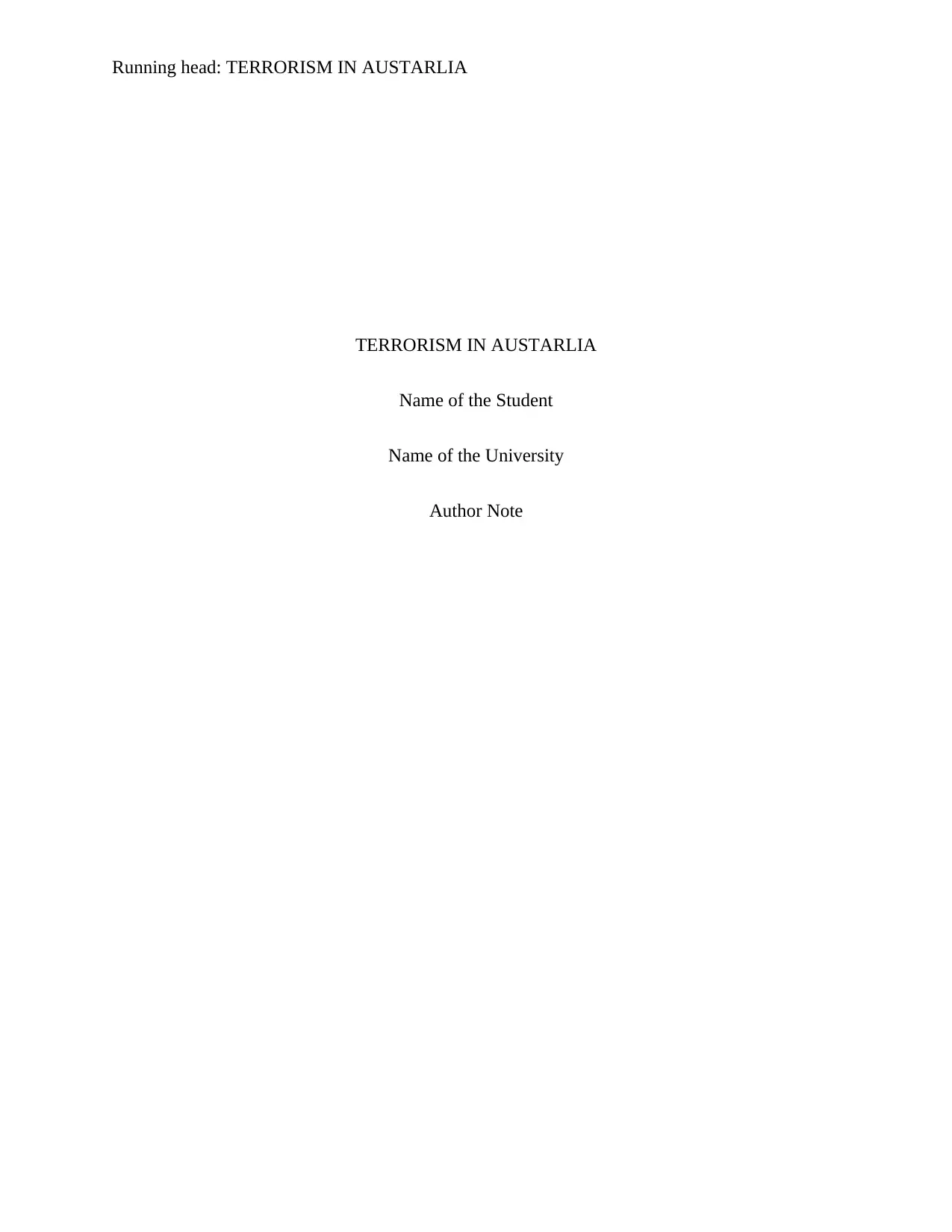
Running head: TERRORISM IN AUSTARLIA
TERRORISM IN AUSTARLIA
Name of the Student
Name of the University
Author Note
TERRORISM IN AUSTARLIA
Name of the Student
Name of the University
Author Note
Paraphrase This Document
Need a fresh take? Get an instant paraphrase of this document with our AI Paraphraser
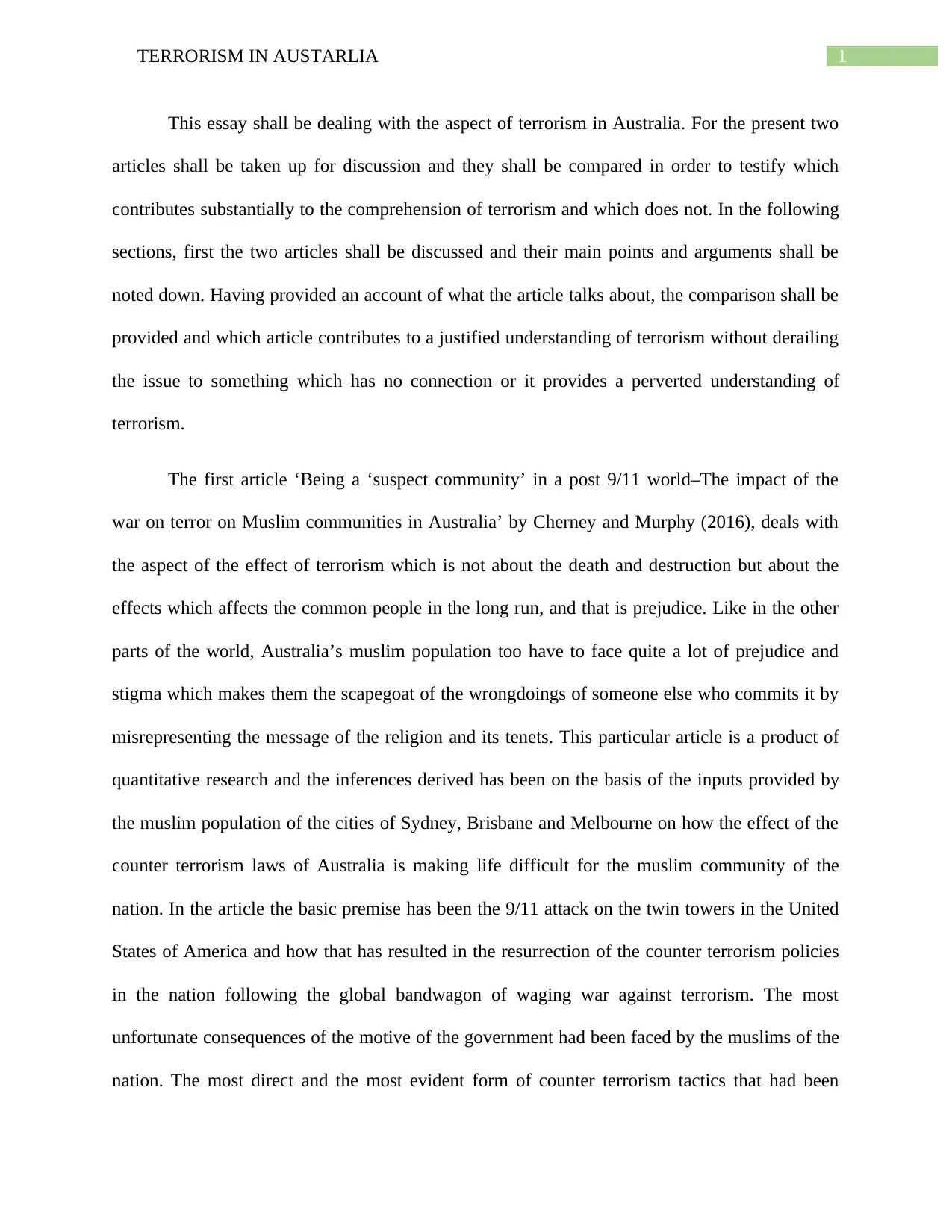
1TERRORISM IN AUSTARLIA
This essay shall be dealing with the aspect of terrorism in Australia. For the present two
articles shall be taken up for discussion and they shall be compared in order to testify which
contributes substantially to the comprehension of terrorism and which does not. In the following
sections, first the two articles shall be discussed and their main points and arguments shall be
noted down. Having provided an account of what the article talks about, the comparison shall be
provided and which article contributes to a justified understanding of terrorism without derailing
the issue to something which has no connection or it provides a perverted understanding of
terrorism.
The first article ‘Being a ‘suspect community’ in a post 9/11 world–The impact of the
war on terror on Muslim communities in Australia’ by Cherney and Murphy (2016), deals with
the aspect of the effect of terrorism which is not about the death and destruction but about the
effects which affects the common people in the long run, and that is prejudice. Like in the other
parts of the world, Australia’s muslim population too have to face quite a lot of prejudice and
stigma which makes them the scapegoat of the wrongdoings of someone else who commits it by
misrepresenting the message of the religion and its tenets. This particular article is a product of
quantitative research and the inferences derived has been on the basis of the inputs provided by
the muslim population of the cities of Sydney, Brisbane and Melbourne on how the effect of the
counter terrorism laws of Australia is making life difficult for the muslim community of the
nation. In the article the basic premise has been the 9/11 attack on the twin towers in the United
States of America and how that has resulted in the resurrection of the counter terrorism policies
in the nation following the global bandwagon of waging war against terrorism. The most
unfortunate consequences of the motive of the government had been faced by the muslims of the
nation. The most direct and the most evident form of counter terrorism tactics that had been
This essay shall be dealing with the aspect of terrorism in Australia. For the present two
articles shall be taken up for discussion and they shall be compared in order to testify which
contributes substantially to the comprehension of terrorism and which does not. In the following
sections, first the two articles shall be discussed and their main points and arguments shall be
noted down. Having provided an account of what the article talks about, the comparison shall be
provided and which article contributes to a justified understanding of terrorism without derailing
the issue to something which has no connection or it provides a perverted understanding of
terrorism.
The first article ‘Being a ‘suspect community’ in a post 9/11 world–The impact of the
war on terror on Muslim communities in Australia’ by Cherney and Murphy (2016), deals with
the aspect of the effect of terrorism which is not about the death and destruction but about the
effects which affects the common people in the long run, and that is prejudice. Like in the other
parts of the world, Australia’s muslim population too have to face quite a lot of prejudice and
stigma which makes them the scapegoat of the wrongdoings of someone else who commits it by
misrepresenting the message of the religion and its tenets. This particular article is a product of
quantitative research and the inferences derived has been on the basis of the inputs provided by
the muslim population of the cities of Sydney, Brisbane and Melbourne on how the effect of the
counter terrorism laws of Australia is making life difficult for the muslim community of the
nation. In the article the basic premise has been the 9/11 attack on the twin towers in the United
States of America and how that has resulted in the resurrection of the counter terrorism policies
in the nation following the global bandwagon of waging war against terrorism. The most
unfortunate consequences of the motive of the government had been faced by the muslims of the
nation. The most direct and the most evident form of counter terrorism tactics that had been
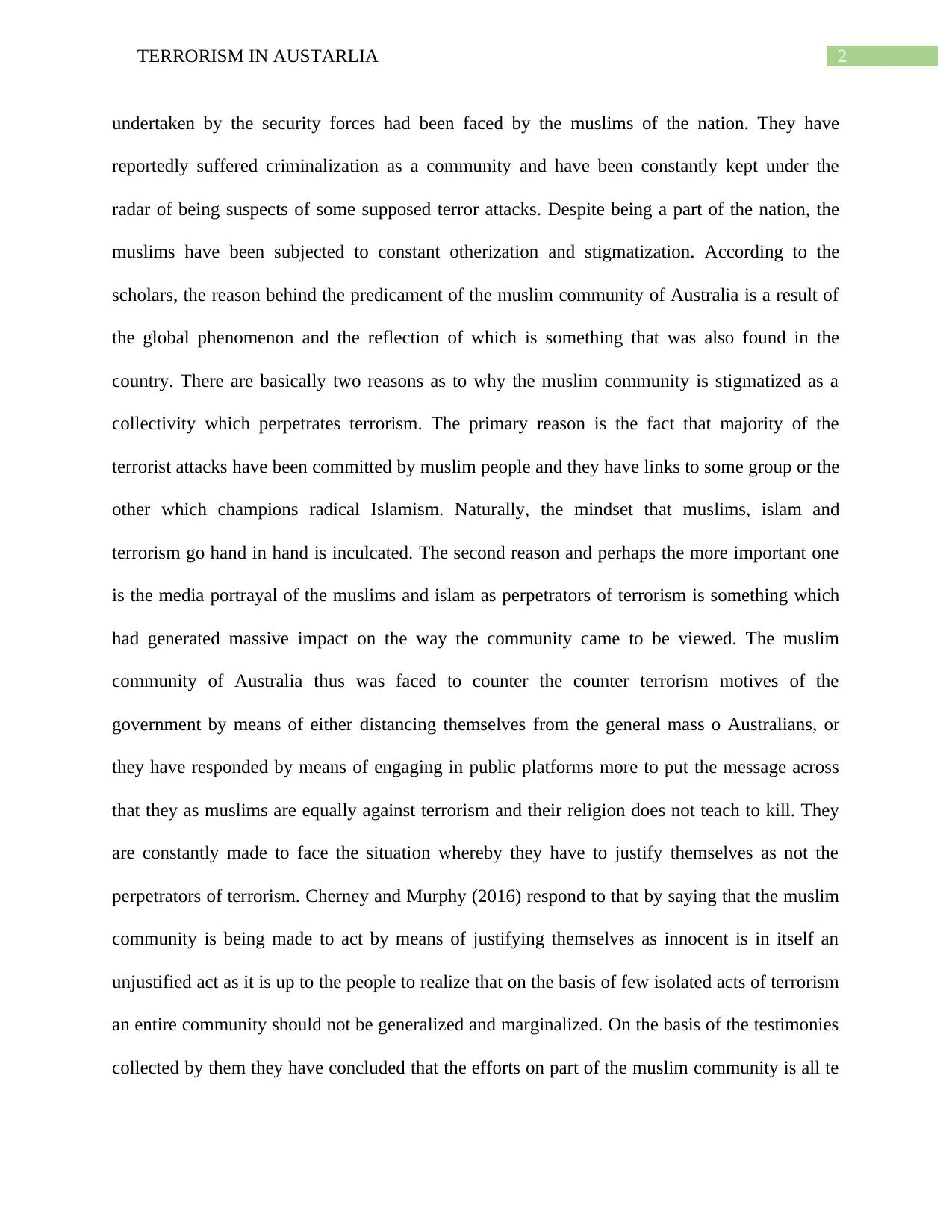
2TERRORISM IN AUSTARLIA
undertaken by the security forces had been faced by the muslims of the nation. They have
reportedly suffered criminalization as a community and have been constantly kept under the
radar of being suspects of some supposed terror attacks. Despite being a part of the nation, the
muslims have been subjected to constant otherization and stigmatization. According to the
scholars, the reason behind the predicament of the muslim community of Australia is a result of
the global phenomenon and the reflection of which is something that was also found in the
country. There are basically two reasons as to why the muslim community is stigmatized as a
collectivity which perpetrates terrorism. The primary reason is the fact that majority of the
terrorist attacks have been committed by muslim people and they have links to some group or the
other which champions radical Islamism. Naturally, the mindset that muslims, islam and
terrorism go hand in hand is inculcated. The second reason and perhaps the more important one
is the media portrayal of the muslims and islam as perpetrators of terrorism is something which
had generated massive impact on the way the community came to be viewed. The muslim
community of Australia thus was faced to counter the counter terrorism motives of the
government by means of either distancing themselves from the general mass o Australians, or
they have responded by means of engaging in public platforms more to put the message across
that they as muslims are equally against terrorism and their religion does not teach to kill. They
are constantly made to face the situation whereby they have to justify themselves as not the
perpetrators of terrorism. Cherney and Murphy (2016) respond to that by saying that the muslim
community is being made to act by means of justifying themselves as innocent is in itself an
unjustified act as it is up to the people to realize that on the basis of few isolated acts of terrorism
an entire community should not be generalized and marginalized. On the basis of the testimonies
collected by them they have concluded that the efforts on part of the muslim community is all te
undertaken by the security forces had been faced by the muslims of the nation. They have
reportedly suffered criminalization as a community and have been constantly kept under the
radar of being suspects of some supposed terror attacks. Despite being a part of the nation, the
muslims have been subjected to constant otherization and stigmatization. According to the
scholars, the reason behind the predicament of the muslim community of Australia is a result of
the global phenomenon and the reflection of which is something that was also found in the
country. There are basically two reasons as to why the muslim community is stigmatized as a
collectivity which perpetrates terrorism. The primary reason is the fact that majority of the
terrorist attacks have been committed by muslim people and they have links to some group or the
other which champions radical Islamism. Naturally, the mindset that muslims, islam and
terrorism go hand in hand is inculcated. The second reason and perhaps the more important one
is the media portrayal of the muslims and islam as perpetrators of terrorism is something which
had generated massive impact on the way the community came to be viewed. The muslim
community of Australia thus was faced to counter the counter terrorism motives of the
government by means of either distancing themselves from the general mass o Australians, or
they have responded by means of engaging in public platforms more to put the message across
that they as muslims are equally against terrorism and their religion does not teach to kill. They
are constantly made to face the situation whereby they have to justify themselves as not the
perpetrators of terrorism. Cherney and Murphy (2016) respond to that by saying that the muslim
community is being made to act by means of justifying themselves as innocent is in itself an
unjustified act as it is up to the people to realize that on the basis of few isolated acts of terrorism
an entire community should not be generalized and marginalized. On the basis of the testimonies
collected by them they have concluded that the efforts on part of the muslim community is all te
⊘ This is a preview!⊘
Do you want full access?
Subscribe today to unlock all pages.

Trusted by 1+ million students worldwide
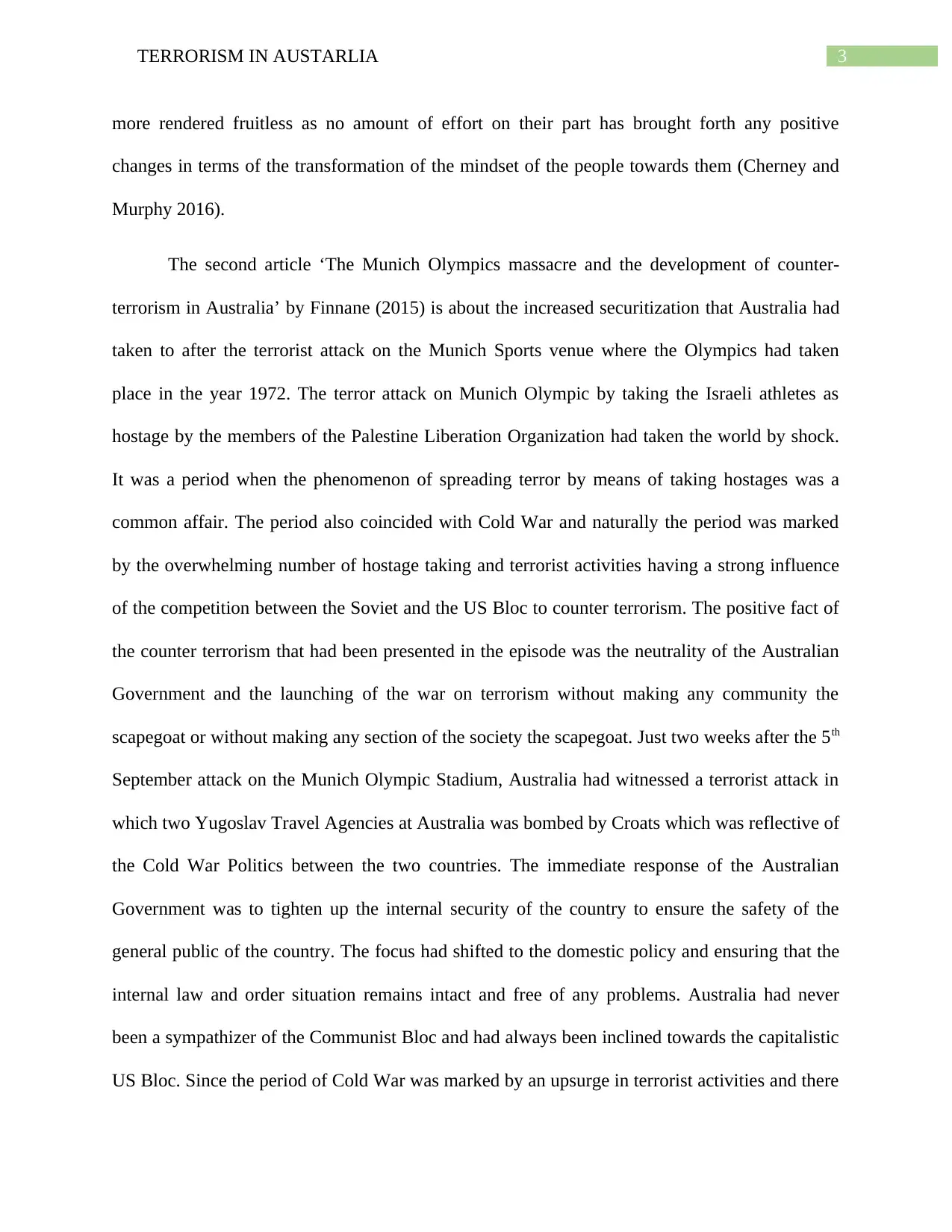
3TERRORISM IN AUSTARLIA
more rendered fruitless as no amount of effort on their part has brought forth any positive
changes in terms of the transformation of the mindset of the people towards them (Cherney and
Murphy 2016).
The second article ‘The Munich Olympics massacre and the development of counter-
terrorism in Australia’ by Finnane (2015) is about the increased securitization that Australia had
taken to after the terrorist attack on the Munich Sports venue where the Olympics had taken
place in the year 1972. The terror attack on Munich Olympic by taking the Israeli athletes as
hostage by the members of the Palestine Liberation Organization had taken the world by shock.
It was a period when the phenomenon of spreading terror by means of taking hostages was a
common affair. The period also coincided with Cold War and naturally the period was marked
by the overwhelming number of hostage taking and terrorist activities having a strong influence
of the competition between the Soviet and the US Bloc to counter terrorism. The positive fact of
the counter terrorism that had been presented in the episode was the neutrality of the Australian
Government and the launching of the war on terrorism without making any community the
scapegoat or without making any section of the society the scapegoat. Just two weeks after the 5th
September attack on the Munich Olympic Stadium, Australia had witnessed a terrorist attack in
which two Yugoslav Travel Agencies at Australia was bombed by Croats which was reflective of
the Cold War Politics between the two countries. The immediate response of the Australian
Government was to tighten up the internal security of the country to ensure the safety of the
general public of the country. The focus had shifted to the domestic policy and ensuring that the
internal law and order situation remains intact and free of any problems. Australia had never
been a sympathizer of the Communist Bloc and had always been inclined towards the capitalistic
US Bloc. Since the period of Cold War was marked by an upsurge in terrorist activities and there
more rendered fruitless as no amount of effort on their part has brought forth any positive
changes in terms of the transformation of the mindset of the people towards them (Cherney and
Murphy 2016).
The second article ‘The Munich Olympics massacre and the development of counter-
terrorism in Australia’ by Finnane (2015) is about the increased securitization that Australia had
taken to after the terrorist attack on the Munich Sports venue where the Olympics had taken
place in the year 1972. The terror attack on Munich Olympic by taking the Israeli athletes as
hostage by the members of the Palestine Liberation Organization had taken the world by shock.
It was a period when the phenomenon of spreading terror by means of taking hostages was a
common affair. The period also coincided with Cold War and naturally the period was marked
by the overwhelming number of hostage taking and terrorist activities having a strong influence
of the competition between the Soviet and the US Bloc to counter terrorism. The positive fact of
the counter terrorism that had been presented in the episode was the neutrality of the Australian
Government and the launching of the war on terrorism without making any community the
scapegoat or without making any section of the society the scapegoat. Just two weeks after the 5th
September attack on the Munich Olympic Stadium, Australia had witnessed a terrorist attack in
which two Yugoslav Travel Agencies at Australia was bombed by Croats which was reflective of
the Cold War Politics between the two countries. The immediate response of the Australian
Government was to tighten up the internal security of the country to ensure the safety of the
general public of the country. The focus had shifted to the domestic policy and ensuring that the
internal law and order situation remains intact and free of any problems. Australia had never
been a sympathizer of the Communist Bloc and had always been inclined towards the capitalistic
US Bloc. Since the period of Cold War was marked by an upsurge in terrorist activities and there
Paraphrase This Document
Need a fresh take? Get an instant paraphrase of this document with our AI Paraphraser
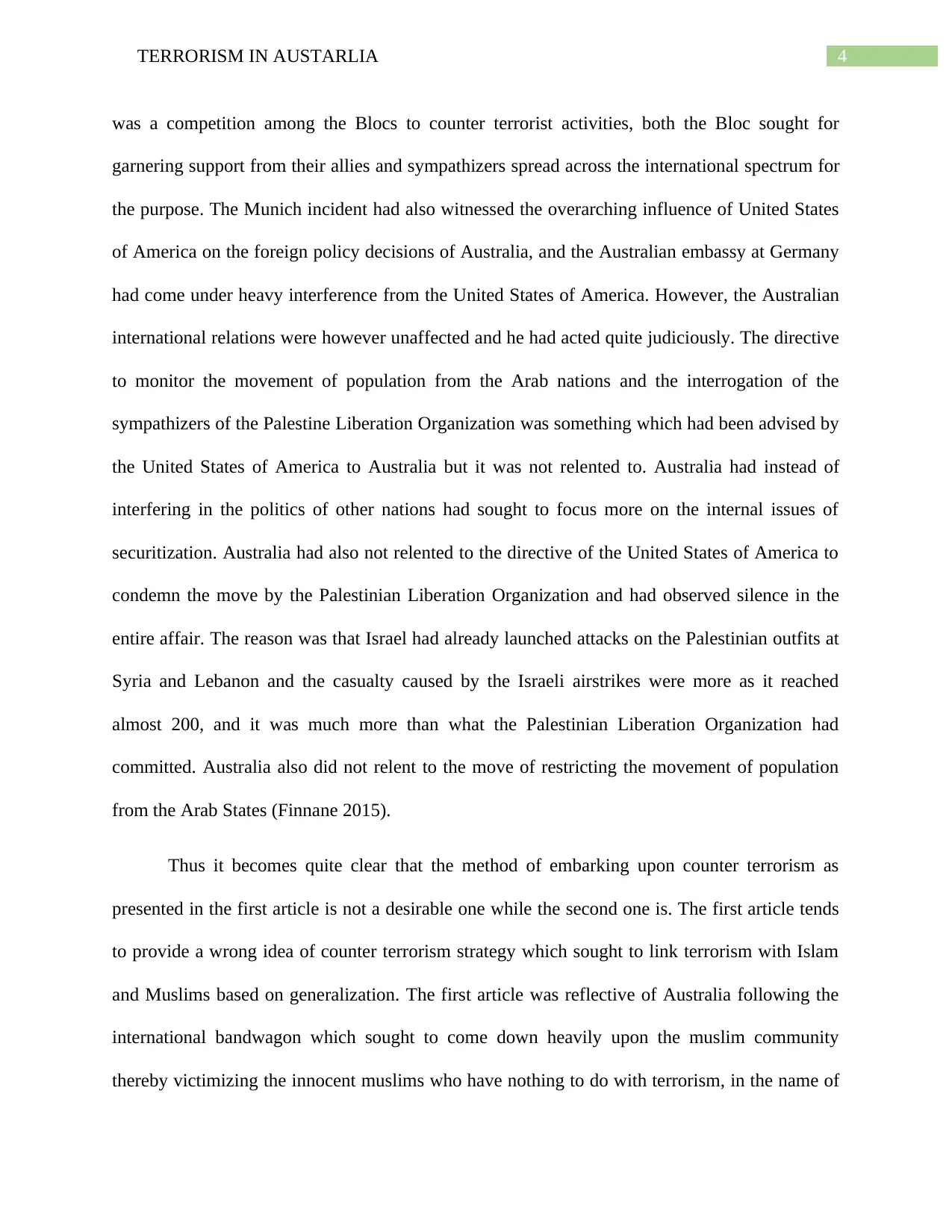
4TERRORISM IN AUSTARLIA
was a competition among the Blocs to counter terrorist activities, both the Bloc sought for
garnering support from their allies and sympathizers spread across the international spectrum for
the purpose. The Munich incident had also witnessed the overarching influence of United States
of America on the foreign policy decisions of Australia, and the Australian embassy at Germany
had come under heavy interference from the United States of America. However, the Australian
international relations were however unaffected and he had acted quite judiciously. The directive
to monitor the movement of population from the Arab nations and the interrogation of the
sympathizers of the Palestine Liberation Organization was something which had been advised by
the United States of America to Australia but it was not relented to. Australia had instead of
interfering in the politics of other nations had sought to focus more on the internal issues of
securitization. Australia had also not relented to the directive of the United States of America to
condemn the move by the Palestinian Liberation Organization and had observed silence in the
entire affair. The reason was that Israel had already launched attacks on the Palestinian outfits at
Syria and Lebanon and the casualty caused by the Israeli airstrikes were more as it reached
almost 200, and it was much more than what the Palestinian Liberation Organization had
committed. Australia also did not relent to the move of restricting the movement of population
from the Arab States (Finnane 2015).
Thus it becomes quite clear that the method of embarking upon counter terrorism as
presented in the first article is not a desirable one while the second one is. The first article tends
to provide a wrong idea of counter terrorism strategy which sought to link terrorism with Islam
and Muslims based on generalization. The first article was reflective of Australia following the
international bandwagon which sought to come down heavily upon the muslim community
thereby victimizing the innocent muslims who have nothing to do with terrorism, in the name of
was a competition among the Blocs to counter terrorist activities, both the Bloc sought for
garnering support from their allies and sympathizers spread across the international spectrum for
the purpose. The Munich incident had also witnessed the overarching influence of United States
of America on the foreign policy decisions of Australia, and the Australian embassy at Germany
had come under heavy interference from the United States of America. However, the Australian
international relations were however unaffected and he had acted quite judiciously. The directive
to monitor the movement of population from the Arab nations and the interrogation of the
sympathizers of the Palestine Liberation Organization was something which had been advised by
the United States of America to Australia but it was not relented to. Australia had instead of
interfering in the politics of other nations had sought to focus more on the internal issues of
securitization. Australia had also not relented to the directive of the United States of America to
condemn the move by the Palestinian Liberation Organization and had observed silence in the
entire affair. The reason was that Israel had already launched attacks on the Palestinian outfits at
Syria and Lebanon and the casualty caused by the Israeli airstrikes were more as it reached
almost 200, and it was much more than what the Palestinian Liberation Organization had
committed. Australia also did not relent to the move of restricting the movement of population
from the Arab States (Finnane 2015).
Thus it becomes quite clear that the method of embarking upon counter terrorism as
presented in the first article is not a desirable one while the second one is. The first article tends
to provide a wrong idea of counter terrorism strategy which sought to link terrorism with Islam
and Muslims based on generalization. The first article was reflective of Australia following the
international bandwagon which sought to come down heavily upon the muslim community
thereby victimizing the innocent muslims who have nothing to do with terrorism, in the name of
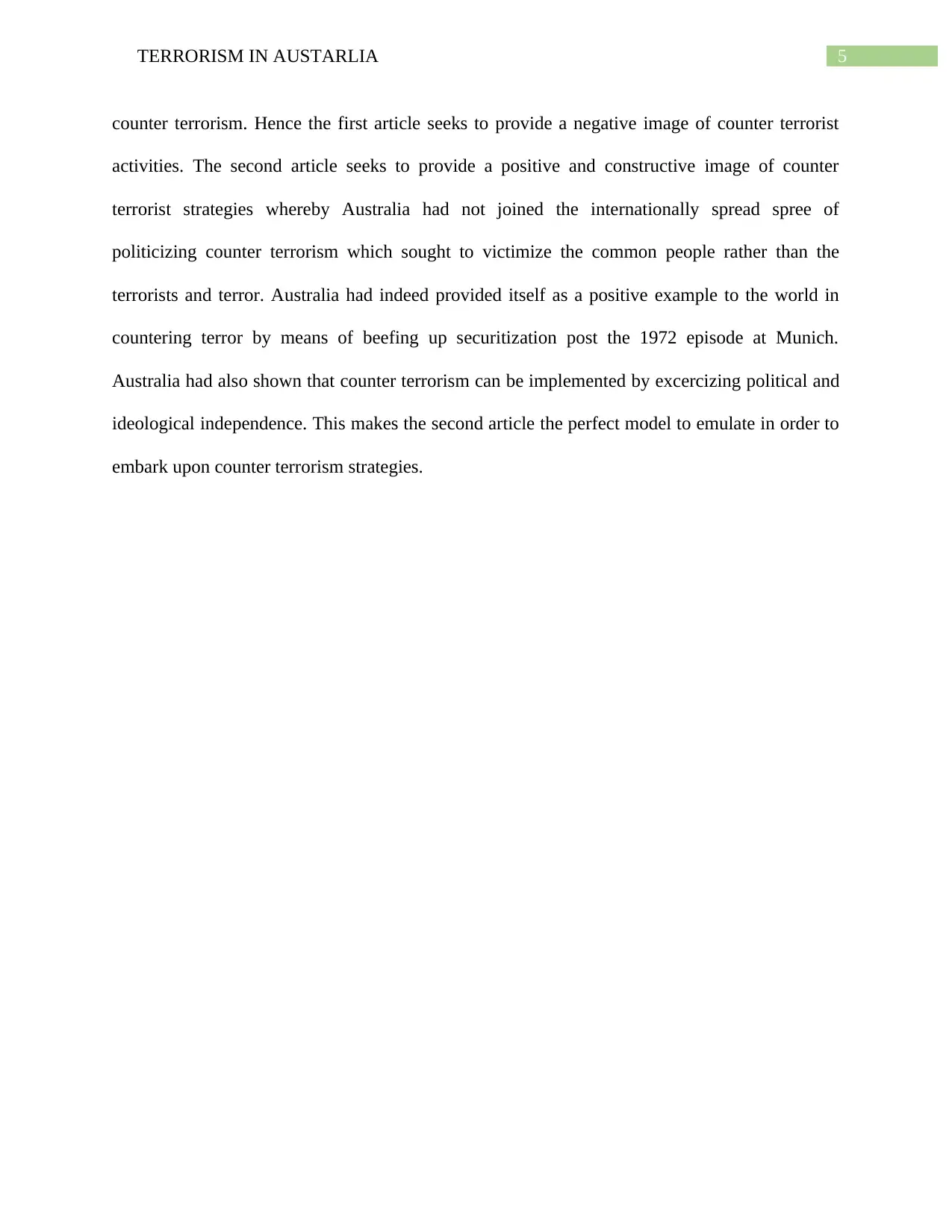
5TERRORISM IN AUSTARLIA
counter terrorism. Hence the first article seeks to provide a negative image of counter terrorist
activities. The second article seeks to provide a positive and constructive image of counter
terrorist strategies whereby Australia had not joined the internationally spread spree of
politicizing counter terrorism which sought to victimize the common people rather than the
terrorists and terror. Australia had indeed provided itself as a positive example to the world in
countering terror by means of beefing up securitization post the 1972 episode at Munich.
Australia had also shown that counter terrorism can be implemented by excercizing political and
ideological independence. This makes the second article the perfect model to emulate in order to
embark upon counter terrorism strategies.
counter terrorism. Hence the first article seeks to provide a negative image of counter terrorist
activities. The second article seeks to provide a positive and constructive image of counter
terrorist strategies whereby Australia had not joined the internationally spread spree of
politicizing counter terrorism which sought to victimize the common people rather than the
terrorists and terror. Australia had indeed provided itself as a positive example to the world in
countering terror by means of beefing up securitization post the 1972 episode at Munich.
Australia had also shown that counter terrorism can be implemented by excercizing political and
ideological independence. This makes the second article the perfect model to emulate in order to
embark upon counter terrorism strategies.
⊘ This is a preview!⊘
Do you want full access?
Subscribe today to unlock all pages.

Trusted by 1+ million students worldwide
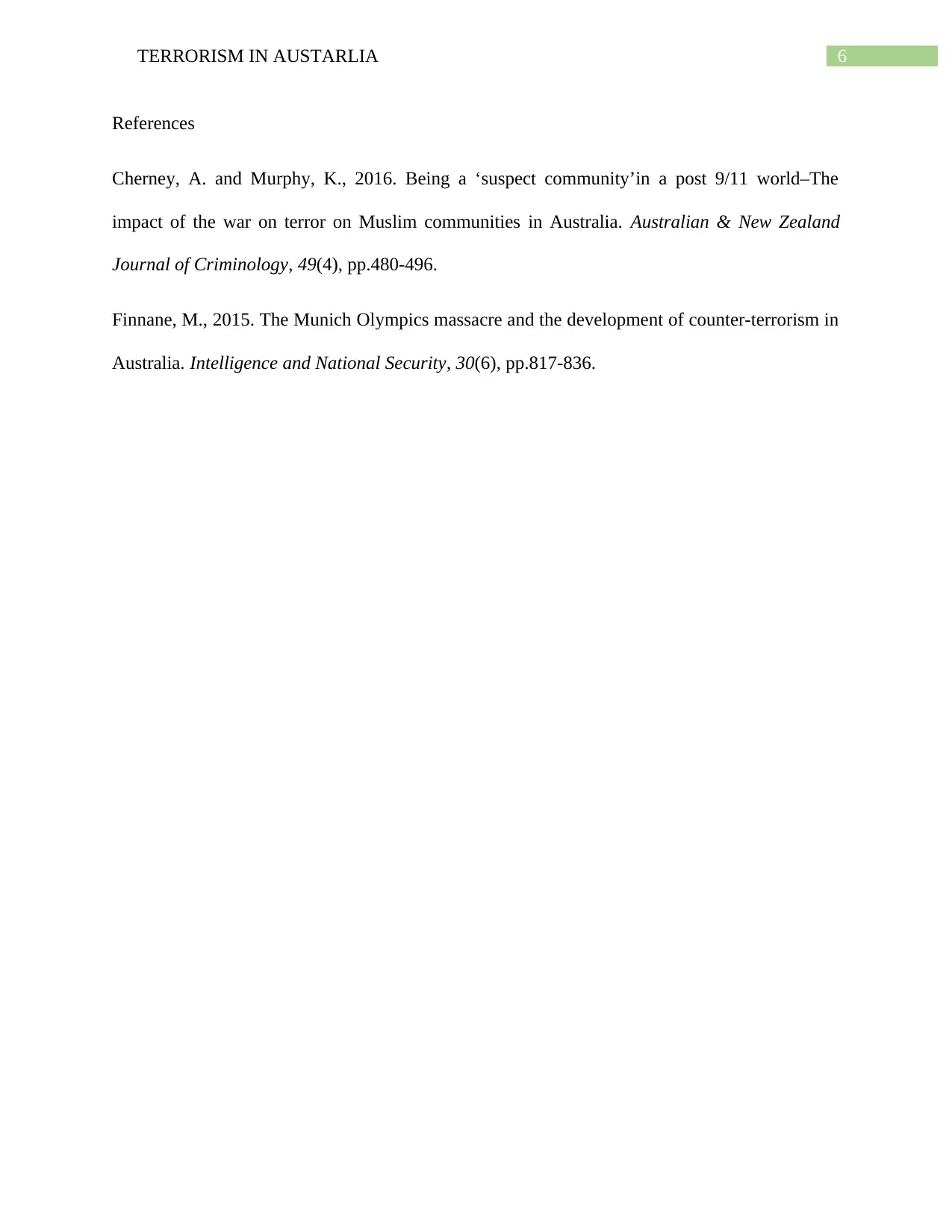
6TERRORISM IN AUSTARLIA
References
Cherney, A. and Murphy, K., 2016. Being a ‘suspect community’in a post 9/11 world–The
impact of the war on terror on Muslim communities in Australia. Australian & New Zealand
Journal of Criminology, 49(4), pp.480-496.
Finnane, M., 2015. The Munich Olympics massacre and the development of counter-terrorism in
Australia. Intelligence and National Security, 30(6), pp.817-836.
References
Cherney, A. and Murphy, K., 2016. Being a ‘suspect community’in a post 9/11 world–The
impact of the war on terror on Muslim communities in Australia. Australian & New Zealand
Journal of Criminology, 49(4), pp.480-496.
Finnane, M., 2015. The Munich Olympics massacre and the development of counter-terrorism in
Australia. Intelligence and National Security, 30(6), pp.817-836.
1 out of 7
Related Documents
Your All-in-One AI-Powered Toolkit for Academic Success.
+13062052269
info@desklib.com
Available 24*7 on WhatsApp / Email
![[object Object]](/_next/static/media/star-bottom.7253800d.svg)
Unlock your academic potential
Copyright © 2020–2025 A2Z Services. All Rights Reserved. Developed and managed by ZUCOL.




